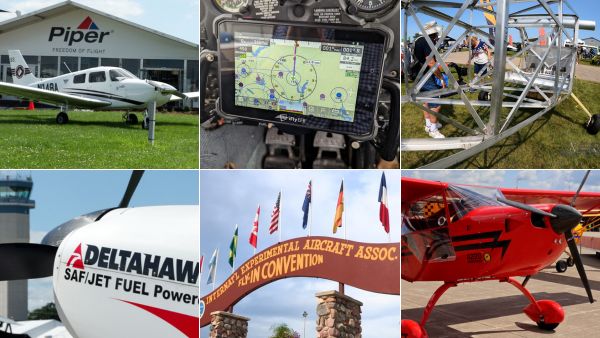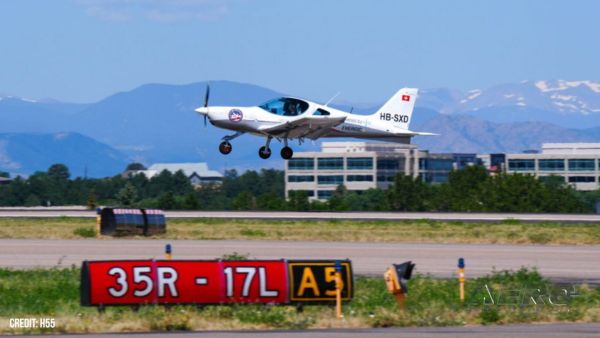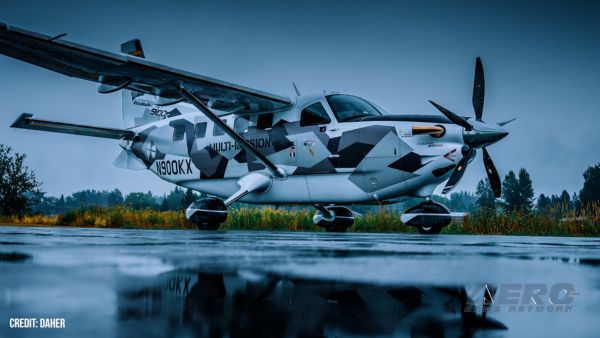"We Really Believed We Would Get Off"
By ANN Correspondent Dave Ziegler
In July of 1942, six Lockheed P-38 Lightning fighters and two
Boeing B-17 Flying Fortress bombers took off from the United States
bound for Duxford, England as part of Operation Bolero, a mission
to ferry aircraft across the Atlantic for deployment in the
European Theater. Forced to turn around by bad weather, and with
insufficient fuel to return home, the entire squadron was forced to
land on a Greenland glacier.
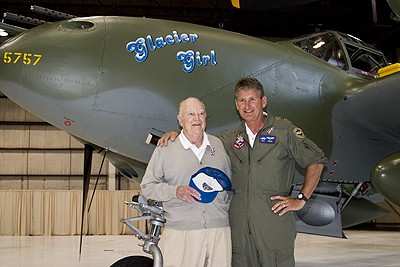
Brad McManus, who at 89 is last surviving member of the famous
"Lost Squadron," was the first to land. "I was the youngest kid in
the flight, and I elected right at that point I'm getting out of
here, I got to get down while I have gas and power." On landing,
the nose wheel of his P-38 dug into the ice causing the aircraft to
flip on its back, but McManus escaped with only minor injury.
McManus (shown above, left, with pilot Steve Hinton) recalled
fellow pilot Harry Smith, who circled his overturned P-38 to check
on him before landing himself. "He landed that airplane and turned
the switches and stopped the propellers before he hit the ground so
he landed … dead stick. He put it in with no power, which
the rest of us were kind of shocked that he did that. But when you
see the picture of the 38 sitting there on the ice, those
propellers are absolutely straight."
 After landing one by one
without major incident, the stranded airmen's immediate concern
turned to survival. "We slept in the B-17," explained McManus.
Despite the harsh environment and difficulties with their radio
signals, he and the other airmen showed great courage and optimism.
"When you're young, you're 23 or 24 years old, you don't worry
about the negatives. We really believed we would get off."
After landing one by one
without major incident, the stranded airmen's immediate concern
turned to survival. "We slept in the B-17," explained McManus.
Despite the harsh environment and difficulties with their radio
signals, he and the other airmen showed great courage and optimism.
"When you're young, you're 23 or 24 years old, you don't worry
about the negatives. We really believed we would get off."
The men stayed warm with improvised space heaters made from
empty oxygen tanks and fueled by engine oil, and they kept their
radio operating by removing the B-17's damaged propeller blades so
the engine could be run for power. Because of their ingenuity and
determination, all 25 pilots and crew survived until ultimately
being rescued several days later, but the aircraft were abandoned
and later swallowed by the ice and snow.
The aircraft of the Lost Squadron remained trapped in ice for
the next 50 years despite eleven attempts between 1977 and 1990 to
recover them. Finally, on the twelfth attempt in 1992, J. Roy
Shoffner and his team successfully recovered a single P-38F (above)
buried in 268 feet of ice - the aircraft originally flown by Harry
Smith.
Restoration of the P-38 began in January of 1993 and, after a
cost of nearly $7 million, was flown as the rechristened Glacier
Girl for the first time on October 26, 2002 by air show and movie
pilot Steve Hinton. His experience flying vintage aircraft, along
with his roles as owner of an aircraft restoration company and
president of the Planes of Fame aviation museum, made Hinton a
logical choice.
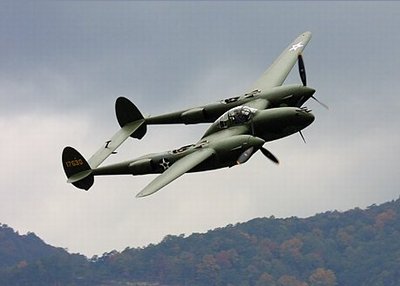
Bob Cardin, who spearheaded Glacier Girl's recovery, and who was
later hired to oversee its restoration, recalled a conversation he
had with Shoffner back in May of 1992 as they struggled against the
elements in Greenland. "Roy said, 'Wouldn't it be something if we
were really able to recover this plane, and we got it flying and we
could finish the mission that these planes were on back in
1942.'"
Shoffner's dream is now becoming a reality, though sadly he did
not live to see it having passed away on September 24, 2005. Thanks
to the many dedicated individuals involved in the project,
including its current owner, Texas businessman Rod Lewis, Glacier
Girl is finally completing its 65 year old mission.
As ANN reported, on June 22
Hinton and Glacier Girl departed Teterboro Airport in New Jersey
bound for Duxford as part of Operation Bolero II, following the
same trans-Atlantic route as the original World War II mission.
"This particular mission means an awful lot to me," Hinton told ANN
shortly before taking off. "This airplane brings so many human
stories to light."
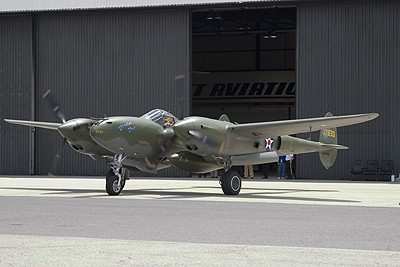
Hinton is not alone. Flying alongside the legendary P-38 is
veteran air show pilot Ed Shipley in the vintage North American
P-51 Mustang, Miss Velma. Additionally, McManus joined Hinton and
Shipley for the first few hundred miles of the mission, flying with
pilot Jim Beasley. "I feel very, very strongly emotionally,"
McManus said about Operation Bolero II. "It's a great day. It's a
historic moment … in aviation history."
McManus expressed his appreciation to those responsible for
Glacier Girl's rescuers. "I just want to add my vote of gratitude
to the owner and to those that have suffered through the recovery
of the plane, started in 1983 and was accomplished on the 15th of
July in 1992."
But it was those responsible for Glacier Girl and Operation
Bolero II that felt they owed thanks to McManus and others. "It's
certainly not about the three of us up here," Shipley explained.
"It's about Brad and all those who have gone before, and all those
people that are serving around the world today."
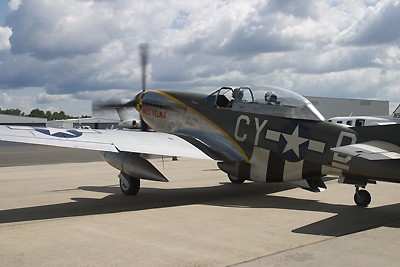
"It really makes me feel great … to be standing here with
Brad, Steve, Rod, Ed, and all of you folks and saying wow, this is
going to take place. This is really what it's all about. It's the
real deal."
Operation Bolero II is not without its dangers, as Hinton
explained before leaving. "[T]here's a high level of risk for this
mission, but Rod Lewis has given us a lot of tools to try to do it
as safe as we can. We have a modern chase plane. Rod himself is
going to lead us there, flying a PC-12, he'll have modern
navigation equipment and survival gear if something goes awry."
(Editor's Note: As of Tuesday, the flight
was grounded due to a mechanical glitch on Miss Velma -- the P-51's
coolant pump gave up the ghost as the crew was preparing to depart
from Goose Bay, after being held at the base over the weekend due
to weather. A new pump has been flown out.)
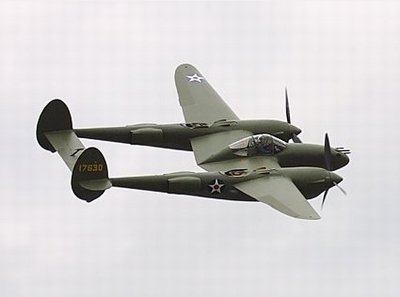
What's in store for Glacier Girl after appearing at AirVenture
this year is unclear, as the historic value of this extremely rare
aircraft must be considered.
"I think we counted about 35 [surviving P-38s]," Hinton
explains, "and that included every crash piece we could think of.
There's only three that fly right now. That's it." As of now,
however, Glacier Girl is expected to remain flying after completing
its mission - a fitting tribute to the many men who bravely flew
these wondrous aircraft in World War II, and to all pilots who fly
in service to their country.
 ANN's Daily Aero-Term (07.15.25): Charted Visual Flight Procedure Approach
ANN's Daily Aero-Term (07.15.25): Charted Visual Flight Procedure Approach Aero-News: Quote of the Day (07.15.25)
Aero-News: Quote of the Day (07.15.25) ANN's Daily Aero-Linx (07.15.25)
ANN's Daily Aero-Linx (07.15.25) NTSB Final Report: Kjelsrud Gary Kitfox
NTSB Final Report: Kjelsrud Gary Kitfox NTSB Prelim: Cessna A150L
NTSB Prelim: Cessna A150L






